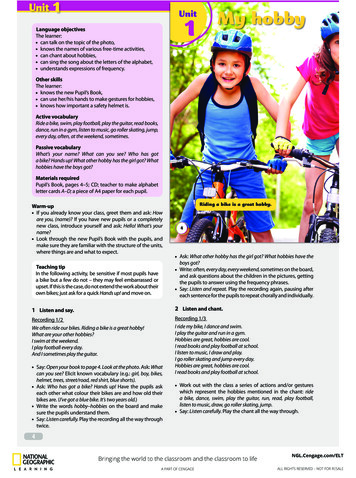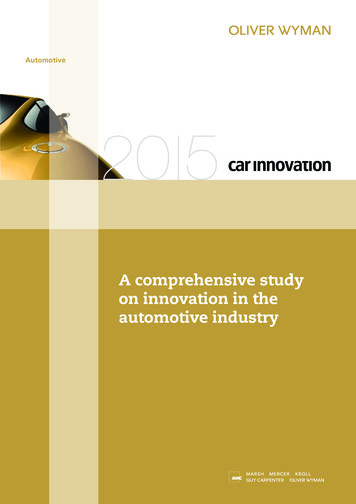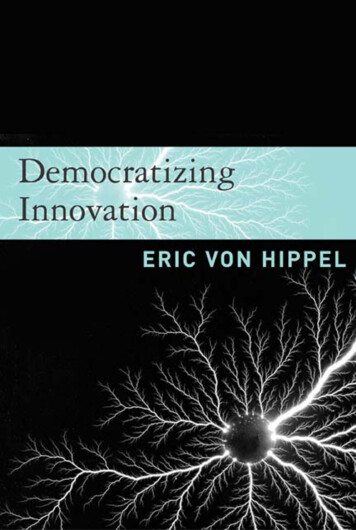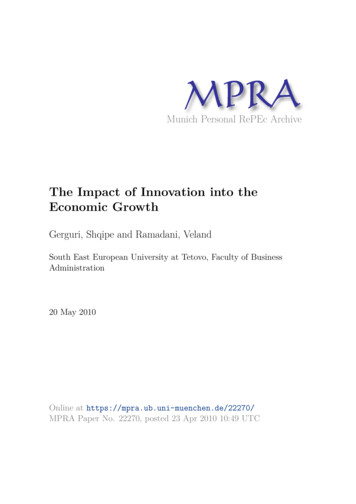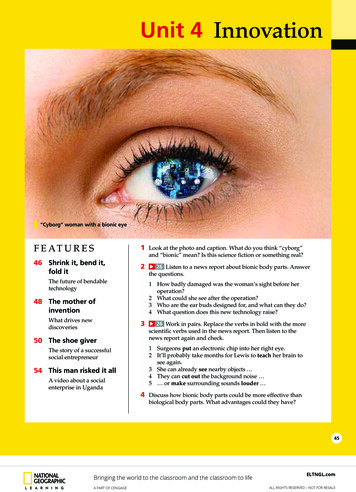
Transcription
Unit 4 Innovation‘‘Cyborg’’ woman with a bionic eyeF E AT U R E S1 Look at the photo and caption. What do you think “cyborg”46 Shrink it, bend it,fold it2and “bionic” mean? Is this science fiction or something real?The future of bendabletechnology1 How badly damaged was the woman’s sight before heroperation?2 What could she see after the operation?3 Who are the ear buds designed for, and what can they do?4 What question does this new technology raise?48 The mother ofinventionWhat drives newdiscoveries350 The shoe giverThe story of a successfulsocial entrepreneur54 This man risked it allA video about a socialenterprise in Uganda26 Listen to a news report about bionic body parts. Answerthe questions.26 Work in pairs. Replace the verbs in bold with the morescientific verbs used in the news report. Then listen to thenews report again and check.1 Surgeons put an electronic chip into her right eye.2 It’ll probably take months for Lewis to teach her brain tosee again.3 She can already see nearby objects 4 They can cut out the background noise 5 or make surrounding sounds louder 4 Discuss how bionic body parts could be more effective thanbiological body parts. What advantages could they have?45Bringing the world to the classroom and the classroom to lifeA PART OF CENGAGEELTNGL.comALL RIGHTS RESERVED – NOT FOR RESALE
4a Shrink it, bend it, fold itReadingWordbuilding -ableWORDBUILDING -able3 Work in pairs. Read the article again and answerthe questions.1 Work in pairs. What everyday objects can you think1 How do 21st-century TVs and cell phonescompare with 20th-century ones?2 Where will the next generation of solar cellsbe placed?3 What is the author’s prediction for bendablescreens?4 Who will be able to launch their own smallsatellites?5 What are the benefits of the new speciallycoated “super-pills”?of that you can shrink, bend, or fold?You can shrink a sweater.What everyday things would you like to be able tomake smaller by shrinking, bending, or folding?2 Work in pairs. Read the article below. Which of thetechnologies in the reading are you most interestedin? Why?SHRINK IT, BEND IT, FOLD IT27510152025There’s something satisfying about things that can bereduced in size and packed away: a folding bicycleyou can take on the train; a jacket you can roll upand put into a bag; folding, unbreakable sunglasses 30you can put in your back pocket. Advances inelectronics and materials science are now pushingthe boundaries of what is possible, helpingmanufacturers to make increasingly smaller, thinner,or more flexible devices. You only have to compare 35a 21st-century television or cell phone with a 20thcentury one to see this. What might the next ten yearsbring?Energy: The idea of harnessing1 solar energy isnothing new, but we may well be about to see arevolution in the construction of solar cells that willallow them to be incorporated into an ultra-thin,transparent film. So instead of expensive solar panelson roofs or in solar farms, in the future they could formpart of the windows on our buildings.Communications: Using screens as thin as a sheet ofpaper, bendable communications technology is alreadyhere. However, chances are that it will become verywidespread in the coming years: phones that wraparound your wrist, or foldable computers that fit intoyour jacket pocket. Perhaps one day soon we will seeTV screens that can be rolled up and carried with us.harness (v.) /ˈhɑːrnɪs/ getting hold of and using2implant (n.) /ˈɪmplɑːnt/ something that is put in yourbody during an operation3stent (n.) /stent/ a small expanding tube used to keeppassageways open in your body (e.g., in arteries)146404550A smartphone thatSpace exploration:unfolds into a tablet“CubeSats”—tiny satellitesmeasuring 10 cm across—havebecome much more affordable:anyone can launch their own satellite nowfor as little as 3,000. This should increaseour chances of making new discoveries in space.Medicine: Doctors are already successfullyrepairing damaged eyesight with tiny electronicimplants2 and opening blocked arteries with smallfoldable stents.3 Progress in bionics is likely tocontinue at a fast pace, although it will almostcertainly raise difficult ethical questions along theway. The other area in which materials scienceis making huge progress is in how drugs aredelivered into the body. New types of coatingaround pills mean each pill can be taken just once,and then the drug inside can be released overweeks and months—even years.It’s likely that such “super-pills”will be inserted directly into thearea needing treatment, suchas cancer cells, increasingthe drug’s effectivenessenormously.A smartphone with abendable screenWe can add the suffix -able to many verbs to form anadjective meaning “something is possible.” The prefixesun-, in-, or non- can also be added to say that “somethingis impossible.”foldable, removable, unbreakable, non-negotiableFor more practice, see Workbook page 29.4 Work in pairs. Look at the wordbuilding box. Thenrewrite the sentences (2–4) using adjectives endingin -able. You will need to change other words in thesentence.1 You can’t reuse those cups: you’re supposed todispose of them.Those cups aren’t reusable; they’re disposable.2 They said this camera couldn’t be broken. I hopethey refund me the money.3 Can I machine wash this jacket or does it have togo to the dry cleaners?4 The car can be repaired. It’s just a question ofwhether I can afford the repair.Grammar future probabilityFUTURE PROBABILITYModal verbsmay (well) / could (well) / might (well), shouldIn the future, they could form part of the windows .We may well be about to see a revolution in solar cells.It should increase our chances of making new discoveries Adverbsperhaps, maybe, probably, almost certainlyIt will almost certainly raise difficult ethical questions.Perhaps one day soon we will see TV screens that can berolled up.Adjective phrasesIt’s possible/probable/(un)likely that; is likely toIt’s likely that in the future “super-pills” will be inserted.Progress in bionics is likely to continue at a fast pace.Noun phrasesThe likelihood is (that), The chances are (that), There’s agood chance (that)The chances are (that) it will become very widespread.For more information and practice, see page 162.5 Work in pairs. Look at the grammar box. Answer thequestions.1 What are the usual positions of an adverb ofprobability?2 Sentences with (un)likely have two possiblegrammatical forms. What are they? Transform eachexample in the grammar box using the other form.6 Look at the expressions of probability againin the grammar box. Discuss which words orphrases mean the following:1234something is possiblesomething is probablesomething is not probablesomething is very sure or almost certain7 Work in pairs. Look at the description ofinnovations. Replace the phrases in bold usingthe words in parentheses.Smart textiles are already here but 1 we willprobably see (chances) a lot more of them inthe coming years. Some innovations will just becosmetic but others 2 are likely to have(may well) practical uses. For example, scientistsbelieve that within the next ten years people3will probably be wearing (likely) clothes thatmend themselves. 4 It’s possible this will mean(could) the end of sewing as we know it.Meanwhile, researchers in China have made afabric that generates electricity as you move. It5is unlikely to produce (probably) large amountsof power but 6 it will probably be (should) enoughto recharge a phone.8 Complete the conversation using one word ineach space. There is sometimes more than onepossible answer. Work in pairs. Discuss if youagree with the speakers’ views.A: Do you think that the problem of internetget worse in thesecurity 1future?B: Well, there 2be a technologicalsolution, but I doubt it. I think what’s more3to happen is that we’ll usethe internet more and more, and internetcrime will almost 4increase.A: I think you’re right. Internet security may5improve, but the criminalswill 6get better at what theydo too.Speakingmy9 Work in pairs. Choose two of the challenges(or your own ideas) that people face in the21st century. Discuss whether technologywill be able to solve them, and if so, how.Use expressions of probability. Traffic congestion and pollution The growing shortage of water Curing illness and diseaseUnit 4 Innovation47
4b The mother of invention1 Work in pairs. Look at the saying below.Discuss what it means and if you thinkit is always true.“Necessity is the mother of invention.”adjectives would you use to describethis invention? What do you think theinventor is trying to achieve?28 Listen to an interview about whatFor more information and practice, see page 162.a Most inventions are an answer to anurgent need.b Most inventions are things that wedidn’t imagine we needed until webecame used to them.c Most inventions come fromcompanies who want to make acommercial profit.choose the correct option to completethe sentences.1 People in their twenties probablycan’t imagine doing research /following the news without theinternet.2 Martha Kay is a business woman /an academic.3 In the nineteenth century, Britishpoliticians said the telephone wastoo expensive / of little use.4 The presenter uses the telephone asan example of a case where a needwas filled / didn’t exist before.5 Most innovations make our livessafer and healthier / easier.6 The presenter suggests that womenin the 1960s liked going out to shop /staying in the house.7 The cell phone and the computer areexamples of innovations that werevery expensive at first /seen as unnecessary.8 Literary Digest predicted that themotor car would remain a luxury /be used by everyone.481 Before cars were commonplace, it(not / be) so easy totake your family on a weekend trip.2 In the 1940s, people(not / own) a television, because radiosprovided news and entertainment.3 Before GPS in cars, people(depend) on printedmaps.4 I never use this microwave oven. I(buy) it.5 In the days before TV, it(be) really exciting togo to the movies!6 I’m not sure who invented the wristwatch. It(be) a Swiss person.7 I think when Tim Berners-Lee invented the(realize)internet, hethat it would have negative as well as positiveeffects.4 should have / ought to have (done)They probably should have been more open-minded.inspires inventions. Circle the statement(a–c) that best summarizes Martha Kay’sview.28 Listen to the interview again andmodal verb form with the words in parentheses.PAST MODALS3 must have, might/may/could have, can’t have (done)Life must have been very different before theinvention of certain things.You might never have considered how people searchedfor information before the internet.It can’t have been easy.2 Look at the photo and the caption. What410 Complete the sentences. Use an appropriate past1 had to (do)They felt they had to find a way to communicate ata distance.2 didn’t need to (do/have done)They didn’t need to have phones.We have so many things around us that we didn’t needto have acquired.Listening3Grammar past modals7 Look at the grammar box. Match the past modalverb forms (1–4) with the uses (a–d).abcdto speculate on past eventsto talk about an obligationto say what was expected or advisableto talk about a lack of necessity8 Work in pairs. Complete the sentences with theCharles Steinlauf’s invention: a four-positionbicycle that also contains a built-in sewing machineVocabulary phrasal verb come5 Look at the sentences. Circle the correct meaning (a–c) ofeach phrasal verb. The first three sentences are from theinterview.1 But how do such inventions come about?a succeedb happenc work2 Entrepreneurs often come up with ideas to make our livesa little more convenient.a think ofb ignorec search for3 Over time, we come to rely on them.a start tob try toc have to4 A researcher came across the material for Post-it noteswhen looking for a new kind of glue.a thought ofb found by chance c stole5 I really don’t like it when strangers come up to me on thestreet and try to sell things.a approachb watchc find6 Work in pairs. Write three sentences using the phrasal verbsfrom Exercise 5. Then read your sentences to your partneromitting the verb and see if they can guess it.correct past modal verb form.may/might/could havemust havecan’t have, it meansa When we usewe are almost certain that something happened/ was true.b When we use, it meanswe are almost certain it didn’t happen / wasn’ttrue.c When we use, it meanswe think it possibly happened / was true.9 Circle the correct options to complete theconversation.A: I didn’t hear you leave this morning. I1must / might have been asleep.B: I left for work very early, actually. But Ishouldn’t 2 bother / have bothered. There was notraffic.A: I think it was a school vacation.That 3 could / should have been the reason. But you4had to wake / should have woken me. I got to worklate in the end.B: Sorry. I was really focused on leaving on time.I 5 must have been / had to be sure of getting to mymeeting.11 Pronunciation weak forms in past modalsa29 Circle the weak forms (words not stressed,including “to”) in these past modal verbs. Thenlisten and check.12345It should have worked, but it didn’t.I had to wait half an hour.He must have forgotten.She may have left already.I didn’t need to be there.b Practice saying the sentences in Exercise 11a.Speakingmy12 Work in groups. Use a range of past modals tospeculate on the answers to these questions.How did people: wake up on time before there were alarm clocks? keep money safe before savings banks existed? deal with aches and pains without medicines? contact each other in an emergency before thetelephone existed? clean their teeth without toothbrushes? detect broken bones before x-rays existed?13 Work in pairs. Think of two commonly usedinventions: one that you couldn’t live withoutand one that you find unnecessary. Discuss theinventions and the reasons you chose them.I couldn’t live without my coffee maker because I drinkso much coffee. I know in the past people used to boilwater on the stove, but it must have taken a long time.Unit 4 Innovation49
4c The shoe giverReading1 Work in pairs and discuss the questions.1 What do you think are the mainpriorities of a business?2 Can you think of ways that a businesscould make money and help society atthe same time?2 Work in pairs. Read the article on page51. Then summarize how TOMS makesmoney and does good at the same time.3 Read the article again. Are the sentencestrue (T) or false (F)?1 Blake Mycoskie’s early career consisted ofstarting and then selling companies.2 The main advantage of the one-for-onescheme is that Mycoskie doesn’t have tokeep asking people to donate money.3 The author suggests that in business,energy and enthusiasm is a veryimportant factor.4 Mycoskie prefers his customers to haveno contact with the recipients of thefree shoes.5 Mycoskie thinks that any businesscould profit from making a similar onefor-one offer to its customers.6 The author thinks that Mycoskie shouldbe proud that he has a successful business,not just one that helps people.Critical thinking findingcounter arguments4 The author presents a positive picture ofTOMS, but there are suggestions that thereare also arguments against the initiative.Find possible criticisms in the text in theseareas.a the price of the productb the business modelc charitable giving5 Work in pairs. Compare your answersfrom Exercise 4. Then write somequestions for Blake Mycoskie that wouldchallenge him on these points.30Word focus give6 Work in pairs. Find this expression with give in the article5and discuss what it means.giving it some thought (line 28–29)7 Complete the expressions with give using these words.Discuss what each expression means.bestbreaktrythoughttime1 It’s difficult to be in a new environment, but give itand you’ll feel more at home.some2 Don’t worry if you don’t win: just give ityour. He’s only been doing the job3 Give him atwo months. He can’t be expected to know everything.4 There’s no need to tell me your answer now. Give itsomeand then let me know.5 The only way to find out if you can fix it yourself is togive it a.8 Match these expressions with similar expressions fromExercise 7. Then make three sentences about your ownexperience using expressions with give.a chanceSpeakinga shot10152025a whilemy309 Work in groups. Imagine these organizations have come toyou for financial help. Decide which you would help. Givereasons.35A This organization collects food near its expiration dateand uses volunteers to distribute it free to homelesspeople. The company needs money for transportationand administration costs.40B This organization sells gardening and landscapingservices to companies. The people it employs are alllong-term unemployed people who get training, workexperience, and a little pocket money.Blake Mycoskie is a serial entrepreneur. He set uphis first business, EZ Laundry, a laundry servicefor students, when he was still at college. Havingbuilt up the company to serve seven colleges in thesouthwestern United States, he sold his share to hisbusiness partner and moved on to an advertisingbusiness in Nashville. This again he sold on to ClearChannel, one of the industry’s leading companies.Three more businesses later, still only 29 years oldand feeling a little burned out from work, Mycoskiedecided to take a break for a while, and headeddown to Argentina for some rest and relaxation.But rest isn’t really part ofan entrepreneur’s make-up,and it wasn’t long beforeMycoskie had hit on anotheridea, one that would cometo define him as perhaps theworld’s best-known socialentrepreneur.The4550Mycoskie knew nothing about manufacturing, letalone shoe manufacturing, but he understood thathe had to learn fast. At first, by his own admission,he made “a poor job of making shoes,” so hebrought in help from people with experience inthe industry. Soon his product was getting highsatisfaction ratings from customers. The vitalelement that Mycoskie added was his own passion.It is a passion he wants others to share. TOMSencourages customers to become more involvedby volunteering to hand-deliver the shoes to thechildren in need. It’s an intimate giving experience,and Mycoskie hopes it might55 inspire volunteers to develop similarprojects.shoegiverOn a visit to a village outsideBuenos Aires, he was shocked to see that many ofthe children didn’t have any shoes; or if they did,the shoes were ill-fitting and badly worn. Sinceshoes—particularly the local farmers’ canvas shoe,the alpargata—are relatively cheap in Argentina,Mycoskie’s first instinct was to set up a charity todonate shoes to the children. But after giving it somethought, he realized that this probably wouldn’twork: the shoes would quickly wear out, and if heasked people to donate repeatedly every time moreshoes were needed, their sympathy for the causemight also soon wear out.So he came up with the idea of TOMS: One forOne shoes. He would take the alpargata to America,manufacture it, and sell it as a high-end fashion itemat around 50 a pair. Quite a lot for a canvas shoeyou might say, but for each pair he sold, another pairwould be donated to village children. That way hecould guarantee a continuing supply and also runthe project as a business rather than as a charity.65707580Ten years on and with revenues of 392 million a year, the business isthriving, supplying shoes not only60 to children in Argentina but alsoother parts of the world where footdiseases are a problem. In southernEthiopia, where a high concentrationof silicone in the soil causes podoconiosis, a diseasethat swells the feet, 300,000 people suffer simplybecause they have no shoes. The same type of soilexists in parts of France and Hawaii, but peoplethere are unaffected.But is the one-for-one model repeatable with otherproducts? TOMS is a for-profit business, but for along time it didn’t show a profit. Mycoskie says hismodel is not like a sales promotion you can just addto your existing business model; you have to buildit in from the beginning. He now diverts a lot ofhis profits into other innovative social ventures. Heis conscious that “giving” alone is not the answer,and that educating people to improve their ownlives is the real key. Yet he still loves TOMS: One forOne, calling it his “greatest hit.”And why shouldn’the? It has made a difference to millions of poorchildren around the world and brought him greatentrepreneurial satisfaction.C This organization collects unwanted clothing. Clothes ingood condition are washed and given to people inneed. Clothes in poor condition are recycled and madeinto fashionable clothing to be sold.10 Work in pairs. Do you know of a company with a socialpurpose?50Unit 4 Innovation51
4d An elevator pitch4e Problem or solution?Real life making a short pitchWriting a proposal1 Read the definition of an elevator pitch. Then1 Work in pairs. Read the proposal and answer thework in pairs. What information do you thinkyou should include? What don’t you need totalk about?questions.1 Does the author think the rise in the use ofdigital devices is a negative trend? How do youknow?2 Why does the author think the declining trendin book reading needs to be reversed?3 Do you think the author’s suggestions are goodones? Why or why not?Imagine you are in an elevator with someone youwant to sell your new (business) idea to. You onlyhave the time until the doors open again to convincethis person. This is known as an elevator pitch.23Introductionmaking an elevator pitch. What points does shemake? Compare the points she makes with yourideas from Exercise 1. Did you agree with whatshe said? Why or why not?This proposal suggests ways teachers can usetechnology to get children to read.MAKING KEY POINTSRhetorical questionsWhat is it?How does it work?What does it do exactly?Why is it/that necessary?Won’t that be expensive?How do we achieve this?What are we asking for?What’s our ambition ?32 Listen to a short pitch for a new phone appand complete the notes in the chart.1What it doesLinks people whowant to volunteer with2Problem it solvesPeople don’t volunteerbecause they can’t commit toa3.CompetitionDoodle and4Why it’s differentHas a database of volunteers’andwith experienceNeeds9tobring it to market4 Speaking skill making key points32 Look at the expressions for making keypoints. Listen again and circle the rhetoricalquestions and sentence adverbs the speaker uses.Can you remember what the speaker said rightafter each question?52focus and remember.expand your vocabulary.improve communication skills.develop analytical thinking.Possible solutions33 Mark where you think the stress falls in eachadverb or adverbial phrase in the box above. Thenlisten and check.33 Work in pairs. Practice saying the words withthe same stress patterns. Then listen again and check.6 Work in pairs or groups of three. Present your own8Children are now spending more time on digitaldevices, browsing on the internet, messaging friends,etc. They are reading fewer books. This mattersbecause reading books is known to help your ability to:ab7Current situation5 Pronunciation word stress6Team ofSentence adverbsBasically, Essentially, Clearly, Obviously, Of course, Honestly, To be honest, Financially, .Practically, So how can we use students’ enthusiasm for digitaldevices to encourage them to read more?5Developers’qualificationsthe questions.1 How is it divided into different sections? Howare different points listed?2 Underline the sentences in the proposal that dothe following.a state the proposal’s aimb state the problem that needs addressingc summarize the writer’s opinion3 Writing skill making recommendationsa Look at the forms used with the verbs suggest and31 Listen to someone giving advice aboutName of app2 Look at how the proposal is organized. Answerelevator pitch. Follow these steps.Student A: Turn to page 153 and read the notes.Student B: Turn to page 154 and read the notes.Student C: Turn to page 155 and read the notes. Prepare your pitch carefully. Use the expressionsfor making key points to help you (use no morethan three rhetorical questions). Speak for no more than a minute. Write down the main message of each pitch andat the end compare your answers. Vote on who you think gave the most persuasivepitch.First of all, we suggest that teachers activelyencourage students to use the internet in class:either to research new subjects or to comparetheir conclusions with other people’s. Second, werecommend using student blogs or learning diariesas a way of sharing ideas. Last, we think technologycould help make reading a pleasure rather thana chore. One idea would be to put screens withinteresting short stories and visuals in a quiet part ofthe classroom. Students could read the stories as areward for finishing other work.RecommendationsThese are just a few examples of how technologycould be an aid to reading. We strongly recommendteachers explore similar ideas. Unless we begin to seetechnology as part of the solution, rather than part ofthe problem, we are unlikely to reverse the trend.recommend. Which forms are used in the proposal?1 recommend / suggest (that) someone (should) dosomething2 recommend / suggest something or doingsomething3 recommend someone do somethingb Complete these recommendations by circling theappropriate verb forms.1 I strongly recommend that people follow /following this advice.2 We suggest that people save / to save theirmoney.3 He recommends you wait / waiting until afterthe summer.4 We are not suggesting that teachers alwaysteach / to teach this way.5 I recommend the company look / looking intothese options.4 Write a proposal that each school student shouldbe given a tablet computer at the age of five.Include the following points. different uses for these tablet computers the benefits they could bring why this is an opportunity not to be missed5 Exchange proposals with your partner. Use thesequestions to check your proposals. Is your partner’s proposal organized in thesame way as the proposal in Exercise 1 (withsub-headings and bullet points)? Has your partner used the language to makerecommendations correctly? Is it a persuasive proposal? Does your partner’sproposal include any points you wish you’dincluded?Unit 4 Innovation53
4f This man risked it allBefore you watch61 Look at the photo and caption. How do you thinkthis activity affects:a the children’s lives? Eco-Fuel Africa turns farm 1intoclean cooking fuel. The fuels burns cleaner and 2and is3cheaper. Eco-Fuel Africa has a network of 2,500 farmersand 460 4retailers. It supplies 5households. Its ambition is to supply 16.6 million householdsin the next 6years. Eco-Fuel Africa prevents 7and8air pollution. It provides a living for farmers and 9and makes sure children get an 10.b the environment?2 Key vocabularya Read the sentences. The words in bold are used inthe video. Guess their meanings.1 I was on the verge of dropping out of college,but my parents persuaded me to stick with it.2 I don’t know why I continued to believe him. Itwas as if I was under a spell.3 We sell some products directly, but mostly theyare sold through retailers.4 We supply over ten million households in thestate with gas and electricity.5 The island has experienced terribledeforestation because the constructionindustry needs wood as a building material.Women and childrencarrying firewood, Ugandab Match the words in bold in Exercise 2a with thesedefinitions.a shops that sell to individualcustomersb large-scale cutting down of treesc just about tod influenced by a powerful (often magical)forcee homesWhile you watch34.1 , 4.2 Watch both parts of the videoand check your ideas from Exercise 1. Whatbenefits did Sanga Moses’s business bring to thecommunity?4 Work in pairs. What do you remember about thefollowing things in the video? 5the process of gathering firewoodSanga Moses’s villagethe process of making the clean fuelthe process of distributing and selling the cleanfuel4.2 Watch Part 2 of the video again. Completethe facts and figures.After you watch74.3 Watch the clips from the video. Choosethe correct meaning of the words.8 Complete the sentences in your own words. Thencompare your sentences with a partner.1 The news that hit people hard.2 It’s important to have a good network offriends because 3 I have an idea to , but I don’t know if Ishould act on it.9 Work in pairs. First summarize the benefits of EcoFuel Africa’s service and then discuss if you seeany potential drawbacks of this system.10 What problem have you seen in your community,and what do you think can be done about it?Think about these areas or one of your own. Thenprepare a short talk to describe the problem andpossible solution. Crime/safetyTransportationPollutionLack of storesNoiseLack of public/recreation spaceJobs4.1 Watch Part 1 of the video again. Work inpairs. Answer the questions.1 What part of his sister’s situation particularlyinspired Sanga Moses to act?2 What did his boss think about his decision toquit his job?3 How many of the university students wantedto help him with his new business venture?4 How did he raise the funds for his new business?5 What was his girlfriend’s reaction?54Unit 4 Innovation55
UNIT 4 REVIEW AND MEMORY BOOSTERGrammarVocabulary1 Read the article and complete it using these words.3 Replace the bold parts of each phrase with anneedhadcertainlylikelychancesmightadjective ending in -able. Some of the adjectivesneed to use the negative form.probablypossible12345A table that can be extended.A mistake that can be forgiven.A car that can’t be relied on.A cover that can be removed.A deposit that can’t berefunded.6 A bag that can be used again.7 A cost that can’t be avoided.4The problem of knowing what information to trust1just have got harder. That’sbecause a Canadian company has recently developeda computer program that can mimic people’s voices.The program does not just copy words, it analyzesspeech patterns to create new sentences in thesame voice. So the person
take your family on a weekend trip.They felt they had to nd a way to communicate at a distance. 2 didn t need to (do/have done) They didn t need to have phones. We have so many things around us that we didn t need to have acquired. 3 must have, might/may/could have, can t have (done) Life must have been very different before the



